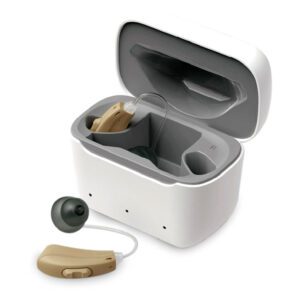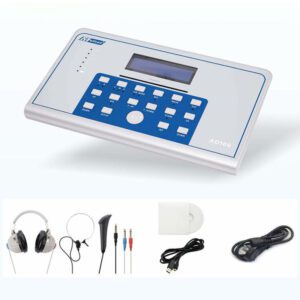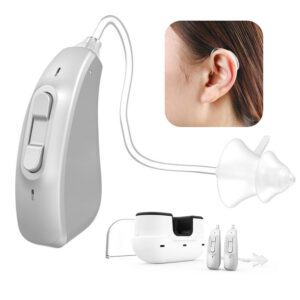Hearing Aid Domes are small, soft, and flexible pieces that are designed to fit over the speaker of a hearing aid device. They come in a variety of shapes and sizes and are made from different materials such as silicone or acrylic. These domes are crucial components of hearing aids as they help to ensure that sound is delivered properly and comfortably to the wearer’s ear.
One of the benefits of using hearing aid domes is that they can be easily replaced or changed. This is particularly useful for people who may have experienced changes in their hearing or have ear canal irritation. Changing the dome can also help to improve the sound quality and reduce feedback or whistling sounds that may occur.
The Benefits of Different Types of Hearing Aid Domes
Hearing aid domes come in various types, and each has its benefits. Here are some of the benefits of different types of hearing aid domes:
- Open Domes: These domes have small openings that allow for natural sound to enter the ear. Open domes are ideal for individuals with mild to moderate Hearing Loss and those who don’t require significant amplification. They are also suitable for those who prefer a more natural sound and don’t want to feel like their ears are completely plugged in.
- Closed Domes: Closed domes are ideal for individuals with moderate to severe hearing loss who require more significant amplification. They help to block out background noise and prevent feedback, resulting in clearer sound. Closed domes are also beneficial for those who have trouble understanding speech in noisy environments.
- Double Domes: Double domes are two domes attached to each other, with the smaller dome fitting inside the larger one. They are useful for individuals with narrow ear canals or those who find that the hearing aid keeps slipping out of their ears. Double domes also provide a more secure fit and can help prevent feedback.
- Power Domes: Power domes are ideal for individuals with severe to profound hearing loss who require a lot of amplification. They have a larger size and a more significant seal, resulting in more power and better sound quality. Power domes also provide a more secure fit and help prevent feedback.
- Tulip Domes: Tulip domes have a tulip-shaped design that helps to direct sound into the ear canal. They are ideal for individuals with mild to moderate hearing loss who prefer a more natural sound. Tulip domes are also suitable for those who experience feedback or discomfort with other dome styles.
In conclusion, selecting the right type of hearing aid dome depends on your hearing loss level, personal preferences, and the activities you engage in. Your audiologist can help you choose the best dome for your needs and ensure that you have a comfortable and effective hearing aid experience.
How to Choose the Right Hearing Aid Dome for Your Needs?
Choosing the right hearing aid dome for your needs is an essential part of ensuring that your hearing aids provide the maximum benefit. When choosing a hearing aid dome, it’s essential to consider the shape and size of the ear canal. A larger dome may cause discomfort or irritation, while a smaller dome may not provide enough amplification. It’s also important to consider the type of hearing aid device being used, as some domes may be more compatible with certain models.
Here are some factors to consider when choosing a hearing aid dome:
- Your Level of Hearing Loss: The degree of your hearing loss is one of the most critical factors in choosing the right hearing aid dome. For example, if you have mild hearing loss, open domes may be suitable. However, if you have severe hearing loss, power domes or closed domes may be more appropriate.
- Ear Canal Size and Shape: The size and shape of your ear canal will also influence the type of hearing aid dome you should use. Double domes may be appropriate for people with a narrow ear canal, while tulip domes may be more suitable for those with a wider ear canal.
- Lifestyle and Activity Level: Your lifestyle and activity level will also influence the type of hearing aid dome you choose. For example, if you engage in a lot of physical activities such as jogging or dancing, you may need a more secure fitting dome such as a power dome.
- Comfort: The hearing aid dome should feel comfortable in your ear. A properly fitting dome will be comfortable and prevent discomfort or pain. It is important to try different types of domes to find the most comfortable one for you.
- Feedback: If you experience feedback, which is a whistling or buzzing noise, when wearing your hearing aids, you may need to switch to a different type of dome that fits more securely in your ear.
In summary, selecting the right hearing aid dome is crucial for optimizing the performance of your hearing aid. Consult with your audiologist to determine the best hearing aid dome for your specific needs and preferences.
Tips for Finding the Best Price on Hearing Aid Domes
- Shop around to compare prices from different hearing aid providers.
- Look for discounts or promotions on hearing aid domes.
- Consider purchasing in bulk to save money.
- Check with your insurance provider to see if they cover hearing aid domes.
- Consider purchasing hearing aid domes online as they may be cheaper.
- Look for hearing aid providers that offer payment plans or financing options.
- Ask your audiologist if they offer any discounts or payment plans.
- Don’t sacrifice quality for a lower price, as a poorly fitting dome can cause discomfort or reduced performance.
- Consider purchasing generic hearing aid domes rather than branded ones, as they may be cheaper without sacrificing quality.
- Ask your audiologist if they offer any trial periods or warranties for hearing aid domes to ensure satisfaction and value for money.
How to Care for Your Hearing Aid Dome and Keep It Working Optimally?
- Clean your hearing aid dome regularly with a soft, dry cloth.
- Use a wax loop or brush to remove any earwax or debris from the dome.
- Avoid using water, alcohol, or other liquids to clean the dome, as it may damage it.
- Store your hearing aid dome in a clean, dry place when not in use.
- Replace your hearing aid dome regularly, as it can become worn or damaged over time.
- Avoid dropping your hearing aid or dome, as it can cause damage.
- Keep your hearing aid and dome away from heat sources, direct sunlight, and moisture.
- Always handle your hearing aid and dome with clean, dry hands.
- Follow the manufacturer’s instructions for cleaning and caring for your specific hearing aid dome.
- Schedule regular check-ups with your audiologist to ensure that your hearing aid and dome are working optimally.
Our Silicone Hearing Aid Domes
Our Hearing Aid Domes are made of soft silicone materials, which are soft and comfortable, safe and elastic, not easy to deform, and serve you for long-term use.
Overall, hearing aid domes play a vital role in the functioning and effectiveness of hearing aids. They help to provide a comfortable and amplified sound experience for people with hearing loss, while also being easily replaceable and customizable.
Interested in learning more? Contact us for a personalized consultation now!



